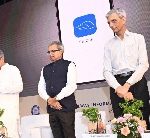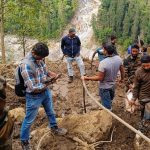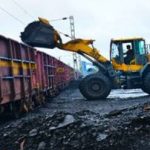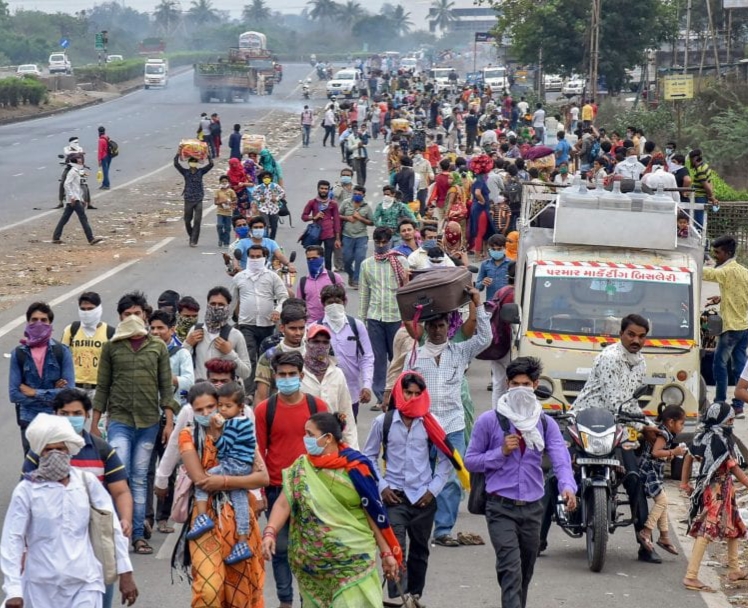
On a clear Covid day you can see forever
Trailokya Jena
It must seem rather churlish to invoke a 1965 song turned into a chart buster by Barbara Streisand to start an emotionally devastating topic of the plight of the migrant labourers across the country. However the song title has already been used to devastating effect first, for a movie in 1970 of the same title and second, punned for the title of John Z DeLorean’s 1979 best seller On a Clear Day You Can See General Motors, a staple diet for MBA courses. Both the book and the film dig deep to bring out lot of dirt and filth from under the surfaces of their respective subjects.
The complete upheaval to usual hustle bustle of daily life caused by the current pandemic has similarly cleared the day to enable us to view mountain peaks from great distance, to find out our favourite childhood stars in the night sky or notice rare birds chirping outside our windows. It also has cleared our vision to see social realities on the streets, roads and highways of the country. The defining images of a nation during total lockdown has been the deeply heart wrenching, and emotionally devastating sight of migrant labourers walking the roads, paltry belongings and children in tow, from cities to their villages lying thousands of kilometres ahead under scorching sun. The media, both mainstream and social, feast on these images blowing thunderous political debates of recrimination while the pandemic dictated lockdown binds the better part of civil society to mute spectatorship. As the camera swoops on their hunger, humiliation and degradation across the heartless cities they have built, and still building, they suddenly become visible to most of the bleeding hearts who have finally discovered them in these covid induced clear summer days! The significance of the Barbara Streisand song ‘On a clear day, rise and look around you…….how it will astound you…..a world you’ve never, never heard before, and on a clear day you can see forever….and ever more’ comes into play after the pandemic has cleared the smog before our eyes, and the media’s among others.
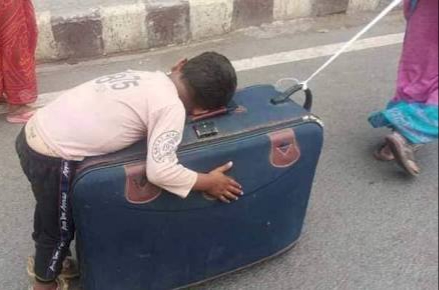
It is not that we are so unaware of this mass of humanity that came out of interior villages of weaker States to seek livelihood in prosperous States. Each one of us must have come across them for decades at the market places and would have directly used them for odd jobs one time or the other. All these while it has been a classic case of seeing but not noticing them. The Indian middle class, who are the main consumer of all kinds of conflict narrative, are so limited in their world and so fixated with climbing upward (to borrow from Pavan Verma’s The Great Indian Middle Class) ‘that they are incapable of looking at those under their social layer’. They consider their lives completely separate from the poor even while using their services in everyday life. They are not compelled to look at anyone below their layer unless presented with some kind of spectacle, the kind they are addicted to in their evening television melodrama. The predatory electronic media in their cut throat competition over rating points know it too well and never waste opportunities for creating spectacles out of human misery.
The country in the middle of a pandemic has been reduced to a Dickensian world where abject degradation of the poor is played out through heart wrenching visuals of men in tatters, women clutching babies, children and the elderly, all trudging on the road to nowhere they call home. It sinks the hearts of countless people already depressed by the never ending lockdowns as they helplessly watch from their confinement and ponder ‘how things really came to this’. The answer may be long if you analyse it systematically questioning the genesis of issues facing these people, their repeated fate of abandonment over the slightest problem at their adopted places and possible and plausible solutions to the commodification and exclusion of migrant labourers as a group. Since these three aspects of the issue involve complex examination, I plan to address these in three parts. This first part will dwell on the genesis of the issue.
At the heart of the problem lies a lack of clear definition of ‘migrant’ in governance structure. The only agency which defines a migrant is the Census Authorities who treat anybody born at one place but living at another is a migrant. According to a 2018 World Bank study Census data on migrants are available upto 2001 figures only as the 2011 figures are yet to be processed. The only working data available are the NSSO figures upto 2007/8 as later figures are yet to be sanitised. Both these sets of data are faulty according to WB report as two thirds of these data include women migrating primarily after marriage. The States which share maximum number of outgoing migrants ( mainly the poorer ones including UP, Bihar, West Bengal, Odisha and Jharkhand) do not have a working database on the migrant labourers whose decision to migrate to other States is typically driven by the spatial earning gap vis a vis their destination States. Only one system has been designed to take care of the migration in the form of reporting by the labour contractors to the State Labour Authorities which is observed mostly in breach mainly to avoid the payments of minimum fees for person taken out of the State besides transgression of rules concerning age and gender of migrants. Those who decide to venture on their own are not covered by any rule. I gathered from my home State of Odisha that it’s Government had taken an initiative to maintain a skeletal data by requiring every Gram Panchayats to compile a list of those who migrate for work outside, but those are not exactly operative to provide any help. Even my weeks of efforts through friends who are Ministers and senior Officers failed to locate the Executive Order issued by Odisha Government in this regard. No wonder no one, the Centre or States, has earthly idea on the number and location of migrants from respective State. No wonder governments were never in a position to be proactive in planning for the migrant labourers at any stage and the present actions are based purely on the blind numbers obtained by way of registrations of migrants wanting to come back home. There are four broad sub sets ( rural to urban, rural to rural, urban to rural and urban to urban )of labour migration prevailing in the market within the main sets of migration within the same State and, in larger numbers, to outside the State. The pattern again is two kinds, round the year migration and Part year migration. Though these intricate movements of people are key requirements for social service schemes, employment guarantee programmes, State benefit distribution, support services provision and voting rights etc, no body has bothered about the data till the COVID pandemic put an x’ray plate of our society to make the inside visible.
Seasonal migration for work is a pervasive reality in rural India. An overwhelming 120 million people or more are estimated to migrate from rural areas to urban labour markets, industries and farms. Migration has become essential for people from regions that face frequent shortages of rainfall or suffer floods, or where population densities are high in relation to land. Areas facing unresolved social or political conflicts also become prone to high out migration. Poverty, lack of local options and the availability of work elsewhere become the trigger and the pull for rural migration respectively.
Migrants form the largest part of India’s vast unorganised work sector. Their entry into the labour markets is marked with several endemic disadvantages. Devoid of critical skills, information and bargaining power, migrant workers often get caught in exploitative labour arrangements that force them to work in low-end, low-value, hazardous work. Lack of identity and legal protection accentuates this problem. The hardships of migrant workers are especially magnified when state boundaries are crossed and the distance between the “source” and “destination” increases. Migrants can also become easy victims of identity politics and parochialism.
Despite the vast numbers of migrant workers, the policies of the Indian state have largely failed in providing any form of legal or social protection to this vulnerable group. In a continuous state of drift, migrants are left out of the scope of state provisions at both ends – the “source” and the “destination”. The urban labour markets treat them with opportunistic indifference extracting hard labour but denying basic entitlements such as decent shelter, fair priced food, subsidised healthcare facilities or training and education. They are also usually out of bounds of government and civil society initiatives, both because of being “invisible” and for their inability to carry entitlements along as they move.
There is one legislation known as Inter-State Migrant Workers Act, 1979 which aims to safeguard migrants. However, it is obsolete and is hardly enforced anywhere. A serious constraint in framing an effective policy is the lack of credible data on incidence of seasonal migration. Census and NSS that have a significant impact on policy making are unable to capture seasonal and circular migration. Importantly, they are mostly unable to participate in the formal electoral system ( though thuggish political systems like the ones followed in West Bengal by CPM in the past and TMC now coerce migrants to come for voting or face consequences ) and are denied a fundamental citizenship right – their right to vote.
Under such circumstances, it was a disaster always waiting to happen. But its magnitude got several golds accentuated by the pandemic situation laced with a draconian lockdown. Equally painful has been the utter poverty and uselessness of the dicourses the media have built around them. The political parties are playing the usual cat and mouse game of the predators. Predators for their vote. A friend forwarded a WhatsApp message on the migrants’ picture which ominously read‘The poor who are walking on foot towards their home are only labourers today, they would be made Hindus only around election time’. Partisan narrative perhaps which I don’t presently buy, but more about the politics later.
( Jena, former Principal Chief Commissioner of Income Tax, will conclude this critical analysis on India’s migrant workforce crisis in three parts)


